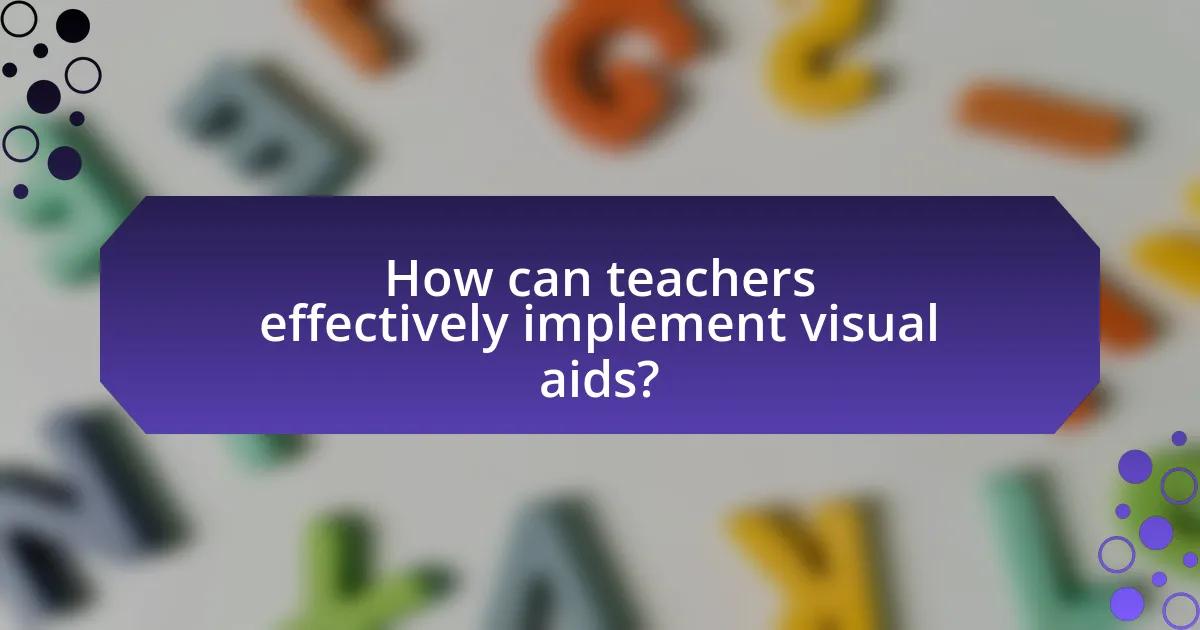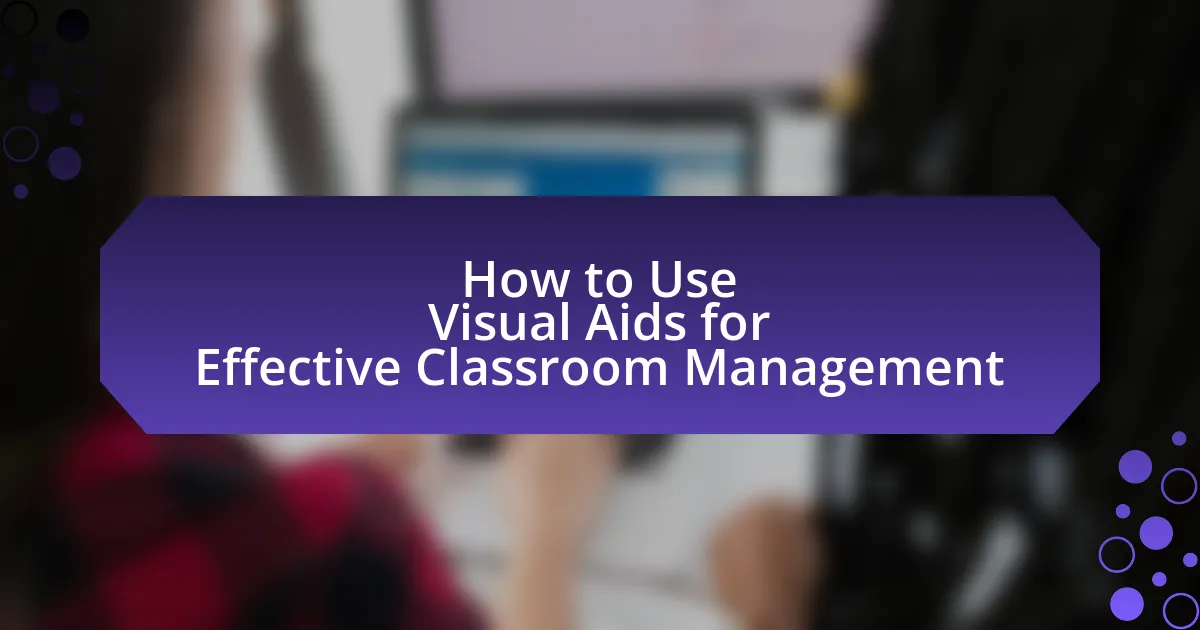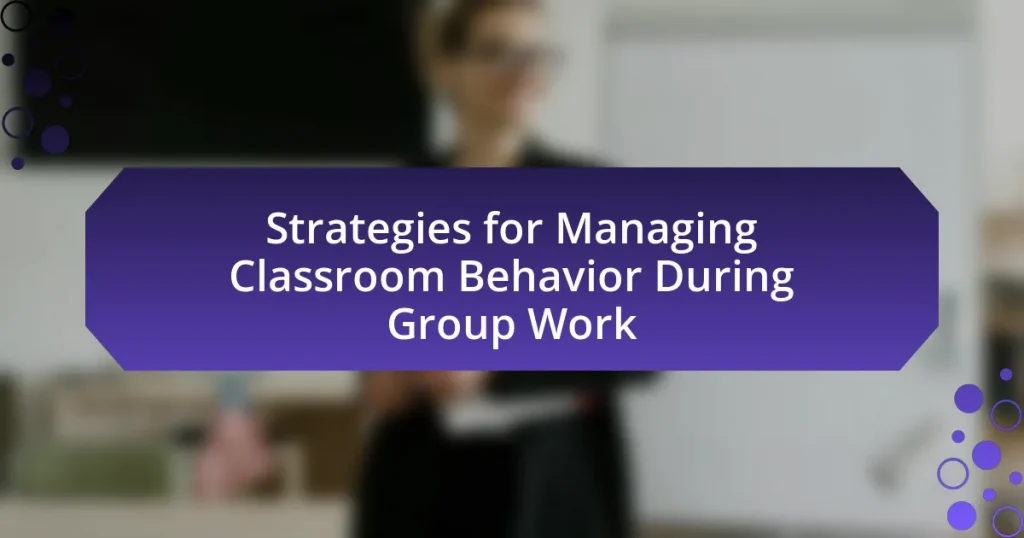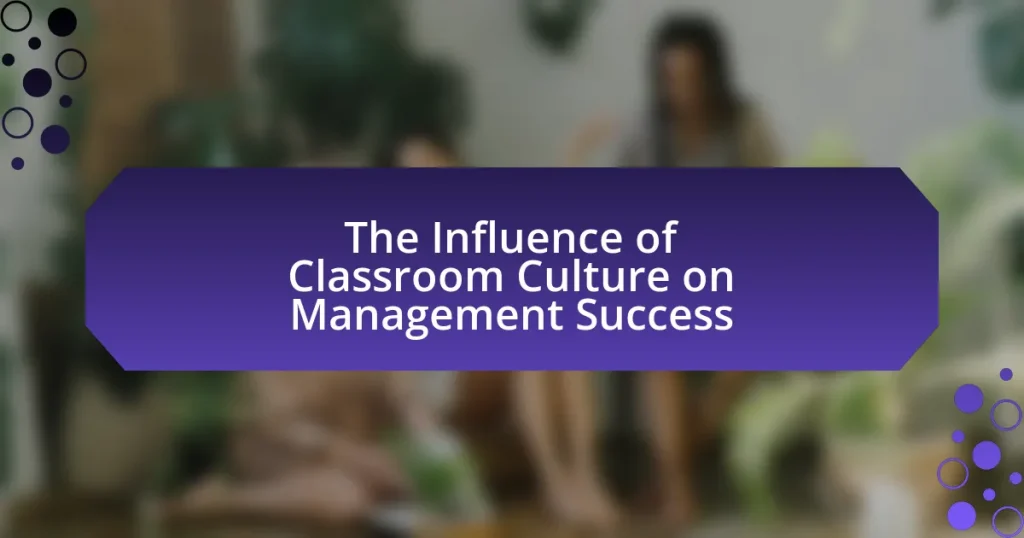Visual aids are essential tools in classroom management that enhance learning by providing visual representations of information, such as charts, diagrams, and videos. Research shows that these aids can improve comprehension and retention by up to 65%, catering to diverse learning styles and making complex concepts more accessible. The article explores the types of effective visual aids, their impact on student engagement and discipline, and strategies for teachers to implement and assess these tools in their curriculum. Additionally, it addresses considerations for students with special needs and the importance of cultural awareness in the use of visual aids.

What are Visual Aids in Classroom Management?
Visual aids in classroom management are tools that enhance learning by providing visual representations of information, such as charts, diagrams, images, and videos. These aids help clarify concepts, engage students, and facilitate better retention of information. Research indicates that visual aids can improve comprehension and recall by up to 65%, as they cater to various learning styles and make abstract ideas more concrete.
How do visual aids enhance learning in the classroom?
Visual aids enhance learning in the classroom by improving comprehension and retention of information. Research indicates that students retain 65% of information when it is paired with relevant visuals, compared to only 10% when presented through text alone. This effectiveness stems from the dual coding theory, which posits that information is better understood when it is processed through both verbal and visual channels. Additionally, visual aids can cater to diverse learning styles, making lessons more accessible and engaging for all students. For instance, a study published in the Journal of Educational Psychology found that the use of diagrams and charts significantly increased students’ ability to grasp complex concepts in subjects like science and mathematics.
What types of visual aids are most effective for classroom management?
Charts, graphs, and visual schedules are the most effective types of visual aids for classroom management. These aids help clarify expectations, routines, and behavioral standards, making it easier for students to understand and follow classroom rules. Research indicates that visual schedules can significantly reduce anxiety and improve on-task behavior among students, particularly those with special needs. For instance, a study published in the “Journal of Applied Behavior Analysis” demonstrated that visual supports led to a 30% increase in compliance with classroom rules among students with autism. Thus, utilizing charts, graphs, and visual schedules enhances classroom management by providing clear, accessible information that supports student engagement and compliance.
How do visual aids cater to different learning styles?
Visual aids cater to different learning styles by providing diverse methods of information presentation that align with individual preferences. For instance, visual learners benefit from diagrams, charts, and images that enhance understanding through visual representation. Auditory learners may engage better when visual aids are accompanied by verbal explanations, while kinesthetic learners can interact with physical models or hands-on activities that incorporate visual elements. Research indicates that using visual aids can improve retention and comprehension, as evidenced by a study published in the Journal of Educational Psychology, which found that students who utilized visual aids scored 30% higher on retention tests compared to those who did not. This demonstrates that visual aids effectively address the varied learning styles present in a classroom setting.
Why are visual aids important for effective classroom management?
Visual aids are important for effective classroom management because they enhance understanding and retention of information among students. By providing visual representations of concepts, such as charts, diagrams, and images, educators can cater to diverse learning styles, making lessons more engaging and accessible. Research indicates that visual aids can improve information retention by up to 65% compared to verbal instruction alone, as noted in a study published in the Journal of Educational Psychology. This increased engagement and comprehension lead to better classroom behavior and participation, ultimately fostering a more organized and productive learning environment.
What impact do visual aids have on student engagement?
Visual aids significantly enhance student engagement by providing visual stimuli that capture attention and facilitate understanding. Research indicates that students retain information better when it is presented visually; for instance, studies show that learners are 65% more likely to remember information when it is paired with relevant images. Additionally, visual aids can cater to diverse learning styles, making lessons more accessible and engaging for all students. This multifaceted approach not only increases participation but also fosters a more interactive learning environment, ultimately leading to improved academic performance.
How do visual aids help in maintaining classroom discipline?
Visual aids help in maintaining classroom discipline by providing clear, engaging, and structured information that captures students’ attention and reduces distractions. When teachers use visual aids, such as charts, diagrams, or videos, they create a focused learning environment that encourages students to stay on task. Research indicates that visual stimuli can enhance understanding and retention of information, which in turn fosters a more disciplined classroom atmosphere. For example, a study published in the Journal of Educational Psychology found that students exposed to visual aids demonstrated improved focus and reduced behavioral issues compared to those who received traditional instruction without visual support.

How can teachers effectively implement visual aids?
Teachers can effectively implement visual aids by integrating them into lesson plans to enhance understanding and retention of information. Utilizing tools such as charts, diagrams, and multimedia presentations can cater to various learning styles, making complex concepts more accessible. Research indicates that visual aids can improve information retention by up to 65% when combined with verbal instruction, as highlighted in a study by Mayer (2009) in “Learning and Instruction.” This approach not only engages students but also reinforces learning through visual representation, thereby improving overall classroom management and student performance.
What strategies can teachers use to incorporate visual aids into lessons?
Teachers can incorporate visual aids into lessons by using strategies such as integrating multimedia presentations, utilizing graphic organizers, and employing hands-on materials. Multimedia presentations, which include videos and slideshows, can enhance engagement and retention by appealing to various learning styles. Graphic organizers, like charts and mind maps, help students visualize relationships between concepts, making complex information more digestible. Hands-on materials, such as models or manipulatives, allow students to interact with content physically, reinforcing learning through tactile experiences. Research indicates that visual aids can improve comprehension and retention, as evidenced by a study published in the Journal of Educational Psychology, which found that students who learned with visual aids scored significantly higher on assessments compared to those who did not.
How can teachers select appropriate visual aids for their curriculum?
Teachers can select appropriate visual aids for their curriculum by aligning them with learning objectives and considering the diverse learning styles of their students. Effective visual aids should enhance understanding and retention of the material being taught. Research indicates that visual aids can improve learning outcomes; for instance, a study published in the Journal of Educational Psychology found that students who engaged with visual materials scored 30% higher on retention tests compared to those who did not. Therefore, teachers should evaluate the relevance, clarity, and engagement level of visual aids to ensure they effectively support the curriculum.
What are some common mistakes to avoid when using visual aids?
Common mistakes to avoid when using visual aids include overcrowding slides with text, using illegible fonts, and failing to engage the audience. Overcrowding slides can overwhelm viewers, making it difficult to focus on key points; research indicates that slides with more than six lines of text can reduce retention by up to 50%. Illegible fonts, particularly those that are too small or overly decorative, can hinder comprehension, as studies show that readability significantly impacts information retention. Lastly, neglecting to interact with the audience while presenting visual aids can lead to disengagement, as active participation has been shown to enhance learning outcomes.
How can visual aids be adapted for diverse classrooms?
Visual aids can be adapted for diverse classrooms by incorporating various formats, such as images, videos, and interactive tools, to cater to different learning styles and abilities. For instance, using infographics can help visual learners grasp complex information quickly, while auditory learners may benefit from accompanying audio explanations. Additionally, providing tactile elements, like manipulatives or 3D models, can engage kinesthetic learners effectively. Research indicates that differentiated instruction, which includes tailored visual aids, enhances student engagement and comprehension, as shown in studies by Tomlinson (2001) in “How to Differentiate Instruction in Mixed-Ability Classrooms.” This approach ensures that all students, regardless of their learning preferences or needs, can access and benefit from the educational content presented.
What considerations should be made for students with special needs?
Students with special needs require tailored instructional strategies and accommodations to support their learning. Considerations include the use of visual aids that are clear, accessible, and engaging, as these can enhance understanding and retention of information. Research indicates that visual supports, such as charts and diagrams, can significantly improve comprehension for students with learning disabilities (Higgins et al., 2005, “The Impact of Visual Aids on Learning”). Additionally, individualized education plans (IEPs) should be developed to address specific needs, ensuring that visual aids align with each student’s learning goals. Implementing these considerations fosters an inclusive environment that promotes academic success for all students.
How can cultural differences influence the effectiveness of visual aids?
Cultural differences can significantly influence the effectiveness of visual aids by affecting interpretation and engagement levels. For instance, colors, symbols, and imagery may carry different meanings across cultures; red may symbolize danger in some cultures while representing good fortune in others. Research by Hofstede (1980) highlights that cultures with high-context communication styles, such as Japan, may rely more on visual cues and implicit messages, making visual aids more effective in those contexts. Conversely, low-context cultures, like the United States, may prefer explicit information, which can lead to misunderstandings if visual aids do not align with these preferences. Therefore, understanding cultural nuances is essential for maximizing the impact of visual aids in diverse classroom settings.

What are the best practices for using visual aids in classroom management?
The best practices for using visual aids in classroom management include ensuring clarity, relevance, and engagement. Clarity is achieved by using simple, easily readable fonts and high-contrast colors to enhance visibility. Relevance involves selecting visual aids that directly support the lesson objectives, thereby reinforcing key concepts. Engagement can be fostered by incorporating interactive elements, such as charts that students can manipulate or infographics that prompt discussion. Research indicates that visual aids can improve retention rates by up to 65%, as they cater to visual learners and help in organizing information effectively.
How can teachers assess the effectiveness of visual aids?
Teachers can assess the effectiveness of visual aids by evaluating student engagement and comprehension during lessons. Observations of student participation, feedback through surveys, and performance on assessments related to the content presented with visual aids provide concrete data on their impact. Research indicates that visual aids can enhance retention and understanding; for instance, a study by Mayer (2009) found that students who learned with visual aids performed better on tests than those who did not. This evidence supports the assessment of visual aids as a valuable tool in classroom management.
What feedback mechanisms can be used to improve visual aid usage?
Feedback mechanisms that can be used to improve visual aid usage include student surveys, peer evaluations, and observational assessments. Student surveys allow educators to gather direct input on the effectiveness and clarity of visual aids, enabling adjustments based on learner preferences and comprehension levels. Peer evaluations provide insights from colleagues, fostering collaborative improvement and sharing of best practices. Observational assessments involve monitoring student engagement and understanding during lessons that utilize visual aids, allowing for real-time adjustments and enhancements. These mechanisms are supported by research indicating that feedback significantly enhances teaching effectiveness and student learning outcomes.
How can teachers continuously update their visual aids for relevance?
Teachers can continuously update their visual aids for relevance by regularly incorporating current events, technological advancements, and student feedback into their materials. This approach ensures that visual aids reflect the latest information and resonate with students’ interests and experiences. For instance, utilizing online resources and educational platforms can provide access to up-to-date graphics and data, while soliciting student input can help tailor visual content to their preferences and learning styles. Research indicates that engaging students with relevant materials enhances their understanding and retention, making the continuous updating of visual aids a critical practice in effective classroom management.
What tips can enhance the use of visual aids in the classroom?
To enhance the use of visual aids in the classroom, educators should ensure that visual aids are relevant, clear, and engaging. Relevant visual aids directly support the lesson objectives, making it easier for students to connect concepts. Clarity is crucial; visuals should be easy to read and understand, avoiding clutter that can confuse learners. Engaging visuals, such as interactive elements or multimedia, can capture students’ attention and foster participation. Research indicates that using visuals can improve retention rates by up to 65%, as they cater to diverse learning styles and help in information processing.
How can technology be integrated with visual aids for better results?
Technology can be integrated with visual aids by utilizing interactive software and digital tools that enhance engagement and comprehension. For instance, platforms like Google Slides or Prezi allow educators to create dynamic presentations that incorporate multimedia elements such as videos, animations, and hyperlinks, which can significantly improve student understanding and retention of information. Research indicates that the use of interactive visual aids can lead to a 20% increase in student engagement and a 15% improvement in information retention compared to traditional methods (Hattie, J. (2009). Visible Learning: A Synthesis of Over 800 Meta-Analyses Relating to Achievement). This integration not only makes learning more appealing but also caters to various learning styles, thereby fostering a more inclusive classroom environment.
What are some creative ways to engage students with visual aids?
Creative ways to engage students with visual aids include interactive infographics, digital storytelling, and augmented reality experiences. Interactive infographics allow students to manipulate data visually, enhancing comprehension and retention. Digital storytelling combines visuals with narratives, fostering creativity and engagement through multimedia presentations. Augmented reality experiences provide immersive learning opportunities, enabling students to visualize complex concepts in a tangible way. Research shows that visual aids can improve learning outcomes by up to 400%, highlighting their effectiveness in educational settings.



